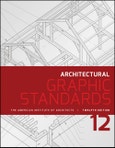The 'Architect's Bible' since 1932, updated with the latest codes and standards
Architectural Graphic Standards is the written authority for architects, designers, and building contractors. It provides comprehensive guidance on the visual representation of materials, products, systems, and assemblies. Updated to reflect the most current codes and standards, this new 12th edition features over 300 new drawings, tables, and designs and twenty-five percent new content. In response to architects' feedback and overwhelming demand for a more graphics-heavy format, this edition employs shorter, more accessible texts and more images of the standards and evolution of design and construction. New coverage includes building resiliency and the building envelope, expert discussion on the fundamentals of design and construction documentation, and new examination of environmental factors and material properties and performance. Sustainable Design is no longer separated, but incorporated throughout, and extensive appendices keep useful data right at your fingertips.
Graphic standards are essential to building design. They cover everything from door frames and roof designs to air ducts and outdoor sports facilities. This meticulous resource provides a compendium of planning standards, optimum dimensions, and normative construction details. The book is organized into three core sections covering: design and documentation, materials, and building elements.
Architectural Graphic Standards features:
- Key architectural design and production processes - functional planning, environmental assessment, building resiliency, and architectural construction documentation
- Thorough coverage of materials: concrete, masonry, metals, wood, plastics, composites, and glass
- An exhaustive survey of building elements - substructures, shells, services, equipment, furnishings, special structures, and siteworks
- Comprehensive appendixes filled with pertinent data such as: classic architectural elements, mathematical data, and structural calculations
Endorsed by the American Institute of Architects, this book has an enduring and unsurpassed reputation for high-quality illustration, text, and graphic design. For crucial information in a user-friendly format, Architectural Graphic Standards is the go-to reference on building design and construction.
Table of Contents
A Note from the Publisher xiii
A Note from the AIA xiv
Architects’ Tributes to Architectural Graphic Standards xv
Introduction xviii
Section 1: Design Principles & Construction Documentation 1
Chapter 1 Functional Planning 3
Human Factors 4
Universal and Accessible Design 19
Chapter 2 Environment 73
Environmental Factors 74
Solar Path and Solar Angle 79
Climate Zone 86
Thermal Comfort 90
Daylighting 92
Acoustics 95
Chapter 3 Building Resiliency 107
Overview 108
Components of Building Resilience 109
Hazard-Specific Building-Resilience Considerations 113
Maintainability 114
Safety 115
Security 122
Security Planning and Design: Continuing Education 127
Sustainability 128
Good Practices in Resilience-Based Architectural Designs 130
Crime Prevention Through Environmental Design 136
Lifecycle Considerations in Resilience-Based Designs 139
Chapter Appendices 140
Chapter 4 Architectural Construction Documentation 141
Drawings 142
Construction Specifications 146
Building Information Modeling (BIM) 151
Procurement Documents 160
Section 2: Materials 161
Chapter 5 Concrete 163
Concrete Forming and Accessories 164
Concrete Reinforcing 170
Typical Components Applicable to Concrete Work 175
Chapter 6 Masonry 181
Typical Components Applicable to Masonry Work 182
Glass Unit Masonry 185
Stone Assemblies 187
Masonry Mortaring and Grouting 191
Masonry Anchorage, Reinforcing, and Accessories 194
Installation Guidelines and Construction Tolerances 199
Chapter 7 Metals 209
Common Characteristics, Standards, and Practices 210
Typical Metal Products Incorporated into Applicable Work Results 216
Decorative Metal 224
Installation Guidelines and Construction Tolerances 228
Chapter 8 Wood, Plastics, and Composites 233
Common Characteristics, Standards, and Practices 234
Wood Classification 236
Wood Treatment 236
Typical Wood, Plastic, and Composite Products Incorporated into Applicable Work Results 240
Installation Guidelines and Construction Tolerances 252
Chapter 9 Glass 259
Common Characteristics, Standards, and Practices 260
Section 3: Building Elements 271
Chapter 10 Element A: Substructure 273
Soils and Soils Explorations 274
Foundations 283
Cast-in-Place Concrete Slab 298
Crawl Space Construction 303
Basement Construction 304
Chapter 11 Element B: Shell 313
Design Considerations 314
Sustainability and Energy 320
Floor Assemblies 322
Roof Assemblies 326
Superstructure 329
Exterior Vertical Enclosures 387
Exterior Horizontal Enclosures 468
Chapter 12 Element C: Interiors 527
Interior Construction 528
Chapter 13 Element D: Services 641
Conveying 642
Other Conveying Equipment 655
Plumbing 659
Heating, Ventilating, and Air-Conditioning (HVAC) 691
Design Considerations 691
Heating/Cooling Source Components 699
HVAC Distribution Arrangements and Components 711
HVAC Delivery Components 722
HVAC Control Systems 725
Fire Protection 732
Electrical 744
Communications 767
Chapter 14 Element E: Equipment and Furnishings 779
Equipment 780
Furnishings 836
Chapter 15 Element F: Special Construction 877
Design Considerations of Integrated Construction 878
Building Modules 878
Manufactured - Fabricated Rooms 881
Special Structures 890
Manufactured Engineered Structures 893
Special Function Construction 898
Special Facilities Components 908
Athletic and Recreation Special Construction 919
Chapter 16 Element G: Sitework 923
Site Earthwork 924
Runoff Control Systems 925
Water Management 930
Basement Excavation 931
Site Grading 936
Site Improvements 938
Parking Lots 942
Porous Pavements 946
Pedestrian Paving 950
Exterior Stairs and Ramps 953
Athletic and Recreational Areas 955
Site Development 966
Landscaping 981
Selecting Plants for Rooftop Planting 991
Site Civil Utilities 993
Porous Paving Systems 995
Storm Drainage Grates 997
Manholes, Inlets, and Catch Basins 999
Site Electrical Utilities 1001
Appendices 1005
A Classical Architectural Elements 1007
B Mathematical Data 1019
C Structural Calculations 1025
Index 1029








